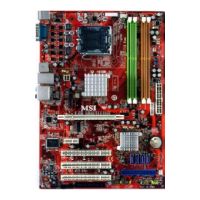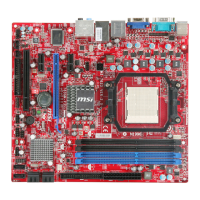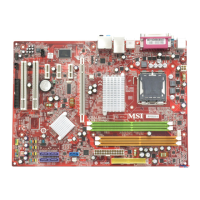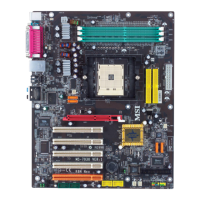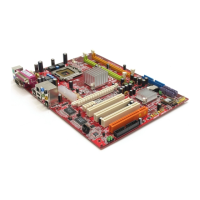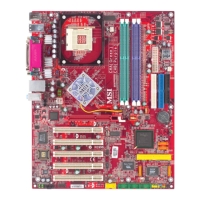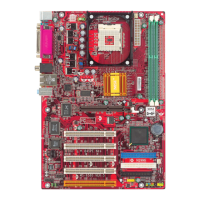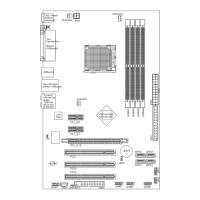Do you have a question about the MSI P31 Neo Series and is the answer not in the manual?
Details the technical specifications of the mainboard, including processor, memory, and connectivity.
Illustrates the physical arrangement of components and connectors on the mainboard.
Lists the items included in the product package, such as motherboard, drivers, and accessories.
Provides a visual guide to the mainboard's components and their locations.
Covers CPU installation, important considerations like overheating, and compatibility.
Explains memory installation, dual-channel configurations, and DDR2 module compatibility.
Details the ATX 24-pin and 12V power connectors and PSU recommendations.
Describes the connectors and ports available on the mainboard's rear panel.
Details various internal connectors like FDD, IDE, SATA, Chassis Intrusion, and front panel headers.
Details the Clear CMOS jumper (JBAT1) and its function for system configuration.
Describes PCI Express and standard PCI slots, including their specifications and IRQ routing.
Guides users on how to access the BIOS setup utility during system startup.
Overviews the main BIOS setup menu options and navigation keys.
Covers basic system configurations like date, time, and detected drives.
Explains settings for boot behavior, CPU features, and chipset configurations.
Details configuration options for onboard controllers like USB, LAN, and ATA devices.
Describes ACPI functions, standby states, and power button behavior for power saving.
Explains Plug and Play and PCI bus configurations, including IRQ resource setup.
Displays system hardware status, including temperatures, fan speeds, and voltages.
Allows adjustment of CPU, DRAM, and other system frequencies and voltages.
Provides options to restore BIOS settings to fail-safe or optimized defaults.
Explains how to set or clear a BIOS password for system security.
Guides on how to launch and activate the Dual Core Center utility.
Introduces the utility's main interface and basic functions for monitoring hardware status.
Explains the automatic overclocking feature for CPU and GPU performance enhancement.
Allows adjustment and monitoring of system and graphics card clock speeds.
Enables adjustment and monitoring of system and graphics card voltages.
Provides controls for adjusting and monitoring system and graphics card fan speeds.
Displays real-time temperature status of the CPU, GPU, and motherboard.
Allows saving and loading custom configurations for clock, voltage, and fan speed.
Step-by-step guide for installing the audio driver from the utility CD.
Explains how to access and use the HD Audio Configuration utility for sound settings.
Details how to select sound effects and use the equalizer for audio customization.
Covers managing equalizer presets, including saving, loading, and deleting settings.
Allows individual adjustment of volume levels for rear and front panel audio outputs.
Guides on configuring multi-channel audio operations and speaker assignments.
Explains options for front panel jack detection and rear panel output muting.
Describes the S/PDIF interface for digital audio transfer and its settings.
Provides a method to test individual speaker functionality and connections.
Covers microphone settings like Noise Suppression and Acoustic Echo Cancellation.
Allows adjustment of 3D positional audio and selection of audio environments.
Displays utility information, driver versions, DirectX, and audio codec details.
| Form Factor | ATX |
|---|---|
| Socket | LGA 775 |
| Memory Type | DDR2 |
| Expansion Slots | 1 x PCIe x16, 2 x PCIe x1, 3 x PCI |
| Audio Chipset | Realtek ALC888 |
| LAN Speed | 10/100/1000 Mbps |
| Supported CPU | Intel Core 2 Quad / Core 2 Duo / Pentium / Celeron |
| FSB | 800/1066/1333 MHz |
| Memory Standard | DDR2 800 / 667 |
| Storage Interface | 4 x SATA 3Gb/s, 1 x PATA |
| USB Ports | 8 x USB 2.0 |
| LAN Chipset | Realtek RTL8111B |
| Chipset | Intel P31 + ICH7 |
